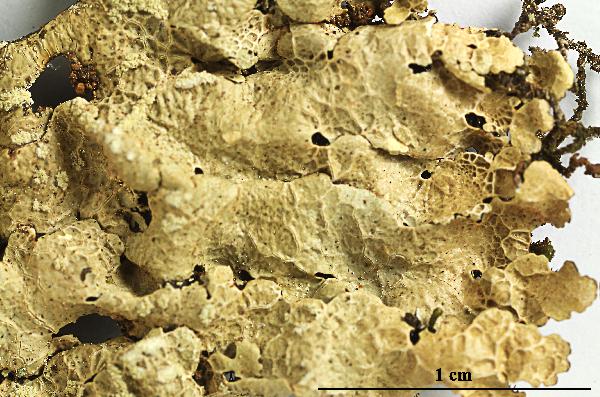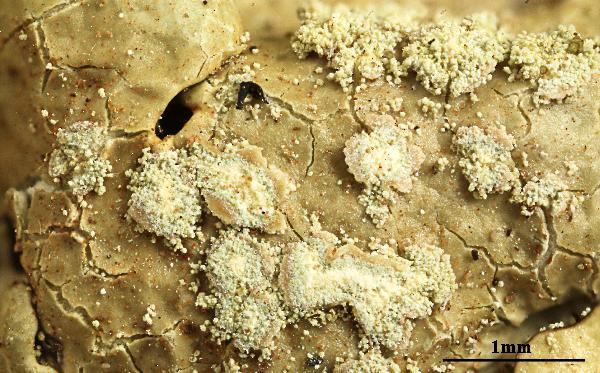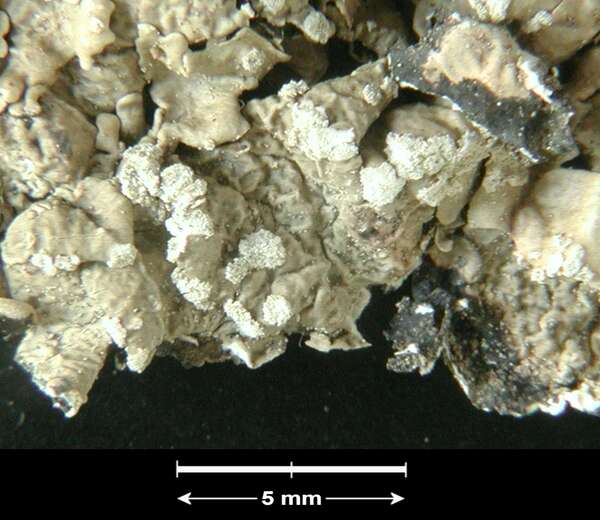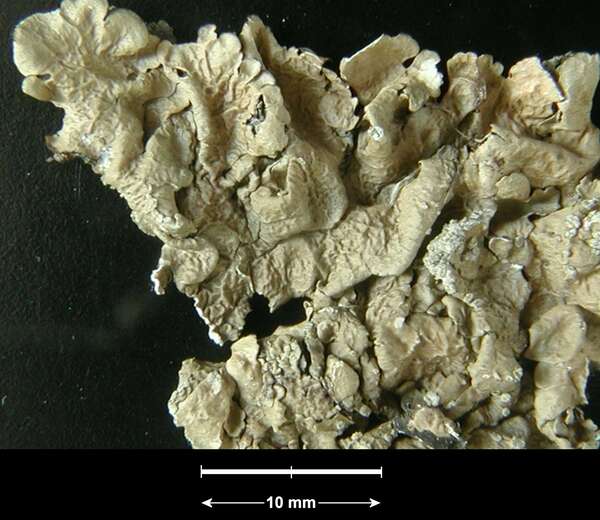Crespoa crozalsiana (Harm.) Lendemer & B.P. Hodk.
N. Amer. Fung., 7, 2: 3, 2012. Basionym: Parmelia crozalsiana B. de Lesd. ex Harm. - Lich. de France, 4: 555, 1910.
Synonyms: Canoparmelia crozalsiana (Harm.) Elix & Hale; Parmotrema crozalsianum (Harm.) D. Hawksw.; Pseudoparmelia crozalsiana (Harm.) Hale
Distribution: N - Lig (Castello & al. 1994, Brunialti & Giordani 2000, 2003, Giordani & al. 2001, Giordani & Incerti 2008, Ravera & al. 2021c). C - Laz (TSB 17670). S - Si (Ottonello & al. 1994, Iacolino & Ottonello 2006).
Description: Thallus foliose, heteromerous, dorsiventral, adnate, sorediate, forming 3-8(-12) cm wide rosettes. Lobes irregularly rounded, (2-)3-5(-8) mm wide, pale to dark grey, eciliate, reticulately ridged to slightly rugose, emaculate or faintly maculate, shallowly foveolate, epruinose or rarely slightly pruinose especially along the margins, cracked in older parts, with laminal, often capitate soralia developing along ridges and cracks; soredia white, granular to farinose. Lower surface black in central parts, with simple, black, to 1.5 mm long rhizines; marginal parts brown, erhizinate. Upper cortex of tightly packed, anticlinally oriented hyphae, with a pored epicortex; medulla white, also below the soralia; algal layer continuous; lower cortex prosoplectenchymatous, with rounded and thick-walled cells. Apothecia extremely rare, lecanorine, up to 3.5 mm across. Asci 8-spored, Lecanora-type. Ascospores 1-celled, hyaline, ellipsoid, 8-13 x (4) 6-8 µm. Pycnidia very rare, black. Conidia thread-like, 12-15 x c. 1 µm. Photobiont chlorococcoid. Spot tests: upper cortex K+ yellow, C-, KC-, P+ yellow; medulla K+ orange, C-, KC-, P+ orange-red. Chemistry: cortex with chloroatranorin and atranorin; medulla with stictic (major), constictic and cryptostictic (minor or traces) acids.Note: a mild-temperate species with subtropical affinities, also reported from North America, locally abundant only - and strangely - in Liguria (especially in Olea-plantations), but also sporadically occurring in other warm-humid areas of Tyrrhenian Italy. It is included in the Italian red list of epiphytic lichens as “Endangered” (Nascimbene & al. 2013c). See also note on C. carneopruinata.
Growth form: Foliose, broad lobed
Substrata: bark
Photobiont: green algae other than Trentepohlia
Reproductive strategy: mainly asexual, by soredia, or soredia-like structures (e.g. blastidia)
Most common in areas with a humid-warm climate (e.g. most of Tyrrenian Italy)
Commonnes-rarity: (info)
Alpine belt: absent
Subalpine belt: absent
Oromediterranean belt: absent
Montane belt: absent
Submediterranean belt: absent
Padanian area: absent
Humid submediterranean belt: extremely rare
Humid mediterranean belt: extremely rare
Dry mediterranean belt: absent

Predictive model
Herbarium samples


Felix Schumm - CC BY-SA 4.0
[ABL80326], Brazil, Mato Grosso do Sul, Naviraí, Fazenda Três
Irmãos, on farm on tree bark. 23°06’08’’ S, 53°48’42’’ W, 300 m. Leg.
A. Aptroot (no 80326), 29.09.2019, det. A. Aptroot, 2019


Felix Schumm - CC BY-SA 4.0
[ABL80326], Brazil, Mato Grosso do Sul, Naviraí, Fazenda Três
Irmãos, on farm on tree bark. 23°06’08’’ S, 53°48’42’’ W, 300 m. Leg.
A. Aptroot (no 80326), 29.09.2019, det. A. Aptroot, 2019


Felix Schumm - CC BY-SA 4.0
[ABL80326], Brazil, Mato Grosso do Sul, Naviraí, Fazenda Três
Irmãos, on farm on tree bark. 23°06’08’’ S, 53°48’42’’ W, 300 m. Leg.
A. Aptroot (no 80326), 29.09.2019, det. A. Aptroot, 2019
Growth form: Foliose, broad lobed
Substrata: bark
Photobiont: green algae other than Trentepohlia
Reproductive strategy: mainly asexual, by soredia, or soredia-like structures (e.g. blastidia)
Most common in areas with a humid-warm climate (e.g. most of Tyrrenian Italy)
Commonnes-rarity: (info)
Alpine belt: absent
Subalpine belt: absent
Oromediterranean belt: absent
Montane belt: absent
Submediterranean belt: absent
Padanian area: absent
Humid submediterranean belt: extremely rare
Humid mediterranean belt: extremely rare
Dry mediterranean belt: absent

Predictive model
| Herbarium samples |


Felix Schumm - CC BY-SA 4.0
[ABL80326], Brazil, Mato Grosso do Sul, Naviraí, Fazenda Três Irmãos, on farm on tree bark. 23°06’08’’ S, 53°48’42’’ W, 300 m. Leg. A. Aptroot (no 80326), 29.09.2019, det. A. Aptroot, 2019


Felix Schumm - CC BY-SA 4.0
[ABL80326], Brazil, Mato Grosso do Sul, Naviraí, Fazenda Três Irmãos, on farm on tree bark. 23°06’08’’ S, 53°48’42’’ W, 300 m. Leg. A. Aptroot (no 80326), 29.09.2019, det. A. Aptroot, 2019


 INDEX FUNGORUM
INDEX FUNGORUM
 GBIF
GBIF



